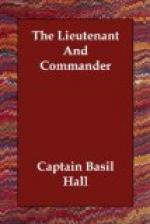Finally, the great monsoons of the Indian ocean and China sea contribute to establish this theory of Hadley, though I am not aware that he ever brought it to bear on these very interesting phenomena. They are eminently deserving of such notice, however, from being periodical Trade-winds of the highest order of utility in one of the busiest commercial regions of the world. Their periodical or shifting character is the circumstance upon which their extensive utility in a great measure depends, amongst nations where the complicated science of navigation is but in a rude state. Myriads of vessels sail from their homes during one monsoon before the wind, or so nearly before it, that there is no great skill required in reaching all the ports at which they wish to touch; and when the wind shifts to the opposite quarter, they steer back again, in like manner, with a flowing sheet. Thus, with an exceedingly small portion of nautical skill, they contrive to make their passages by means of what we blue-jackets call “a soldier’s wind, there and back again.” It will sometimes happen that these rude navigators miscalculate their time, or meet with accidents to retard them till the period of change has gone past, and then they have no resource but to wait for half-a-year till the monsoon shifts.
Experienced sailors, in like circumstances, acquainted with the varieties of winds prevailing in those seas, would speedily get their vessels out of this scrape, into which the lubberly Chinese junks sometimes fall. They might, and certainly would, lose time in making a roundabout of some two or three hundred miles in searching for a wind; but, if they really knew what they were about, they would be sure to catch it at last, and to turn it to their purpose.
From April to October, when the sun’s rays fall with greatest effect on Arabia, India, and China, and the several interjacent seas to which these immense countries give their name, the air in contact with them, becoming heated, rises, and gives place to fresh supplies drawn from the equator. But this equatorial mass of air has had imparted to it by the earth’s rotation a greater degree of velocity in the direction from west to east than belongs to the countries and seas just mentioned; and this additional velocity, combined with its motion from the equator, in rushing to fill up the vacuum caused by the rarefaction of the air over those regions intersected by the tropic, causes the south-west monsoon. “This wind,” says Horsburgh, “prevails from April to October, between the equator and the tropic of Cancer, and it reaches from the east coast of Africa to the coasts of India, China, and the Philippine Islands; its influence extends sometimes into the Pacific Ocean as far as the Marian Islands, on to longitude about 145 deg. east, and it reaches as far north as the Japan Islands.”
The late Captain Horsburgh thus describes what takes place in the winter months:—“The north-east monsoon,” he says, “prevails from October to May, throughout nearly the same space that the south-west monsoon prevails in the opposite season mentioned above. But the monsoons are subject to great obstructions by land; and in contracted places, such as Malacca Strait, they are changed into variable winds. Their limits are not everywhere the same, nor do they always shift exactly at the same period.”




